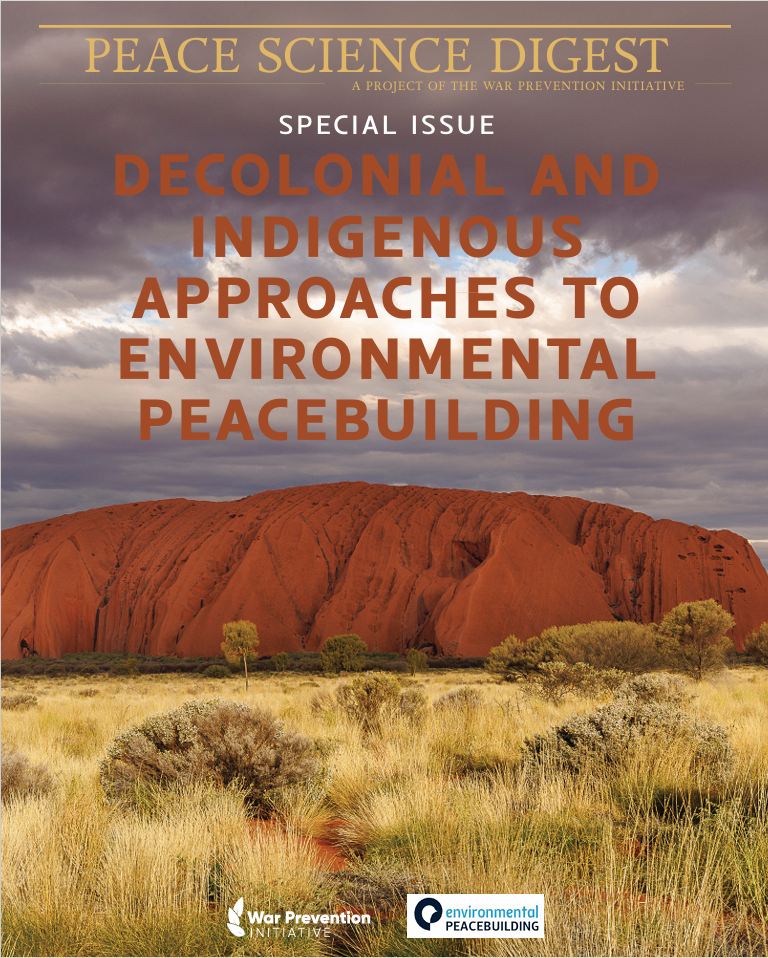In partnership with the Environmental Peacebuilding Association
Environmental peacebuilding emerged from the convergence of multiple fields—like political science, environmental science, peace and conflict studies, and ecology—concerned with how the natural environment shapes conditions for peace and conflict. In an era of rapidly changing environmental conditions due to climate change, it is critically important that peacebuilders better understand how environmental realities could open new opportunities for—or negatively influence—peaceful outcomes in conflict-affected contexts. At the same time, environmental scientists must also better understand the principles and strategies of peacebuilding so that their work both avoids reinforcing violence and actively contributes to peace. According to a foundational article in the field, “environmental peacebuilding comprises the multiple approaches and pathways by which the management of environmental issues is integrated in and can support conflict prevention, mitigation, resolution, and recovery.”(1) Thus, the field aims to bring together experts from multiple disciplines with the shared purpose of managing the natural environment in a way that helps build peace.
The War Prevention Initiative has a keen interest in the study and practice of environmental peacebuilding, especially as climate change poses one of the greatest existential threats to planetary life. A foreign policy and national security policy focused on addressing the greatest actual human security threats would center efforts to mitigate climate change, pursue environmental justice, and meaningfully contribute to peacebuilding worldwide. Current U.S. foreign and security policy, by contrast, continues to rely heavily on the U.S. military, which itself contributes massive carbon emissions to the atmosphere while also harming ecosystems (not to mention human life) through weapons testing, the operation of its military bases, and, of course, war-fighting. Applying an environmental lens to questions of peace and security, therefore, adds a new layer to criticism of the primacy of military solutions in U.S. foreign and security policy by shining a spotlight on both the military’s contributions to climate change and environmental destruction and its inability to address the most critical of security issues.
If we are to conceive of a new security paradigm—one that rejects military solutions and asserts that security is achieved by addressing human needs and preserving planetary life—then we should look at alternatives to the Western/European systems of governance that have structured the global order over the past several centuries. This special issue—focused on decolonial and Indigenous approaches to environmental peacebuilding—explores Indigenous (and bottom-up) perspectives on the environment, peace, and conflict in a variety of contexts. Our intention is that this special issue inspire new thought, conversations, and practices in environmental peacebuilding responsive to an awareness of power dynamics and invigorated by Indigenous knowledge and experience. We are extremely grateful for our friends at the Environmental Peacebuilding Association for collaborating with us on this special issue.
(1) Ide, T., Bruch, C., Carius, A., Conca, K., Dabelko, G. D., Matthew, R., & Weinthal, E. (2021) The past and future(s) of environmental peacebuilding. International Affairs, 91(1). doi: 10.1093/ia/iiaa177
Analyses
Exploring Bottom-Up Environmental Peacebuilding in Timor-Leste
The local customary dispute resolution practice of Tara bandu—practiced throughout Timor-Leste to manage natural resources and address communal or interpersonal violence—is an example of successful, bottom-up environmental peacebuilding.
Decolonial Environmental Peacebuilding in Colombia
In the context of a campesino community in southwestern Colombia, the coca leaf, widely known as the primary ingredient for cocaine, is commonly associated with illicit markets and violence but can be a source of environmental peacebuilding.
Genuine Security as an Alternative to U.S. Militarization of Oceania
U.S. control over the Pacific Ocean constitutes a form of colonial empire sustained by militarization and environmental exploitation.
Transitional Justice as a Response to Conservation Violence against Indigenous Peoples
Conservation violence against Indigenous Peoples can be understood as a proper concern of transitional justice, as it entails “large-scale past abuses,” and the present moment constitutes a period of transition towards greater recognition of Indigenous rights in relation to environmental protection.
Water Cooperation as “Imperfect Peace” amid Conflict and Insecurity
Although the riparian countries have not reached a comprehensive, binding treaty on water sharing, multiple state and non-state actors in the region have developed water governance mechanisms and other forms of cooperation related to water management despite ongoing violent conflict and instability—a situation the authors describe as “imperfect peace.”
Research to Action
Spotlight: Environmental Peacebuilding in the Columbia and Snake River Basin
The Columbia River and the Snake River are lifelines for endangered salmon and other fish. Tribal nations, tribally led non-profit organizations, and other stakeholders have collaborated in environmental peacebuilding efforts to ensure healthy riverways.
We conducted a series of interviews with experts to gain deeper insight into Indigenous and decolonial approaches to environmental peacebuilding.
Download and read the full special issue via the link below:

